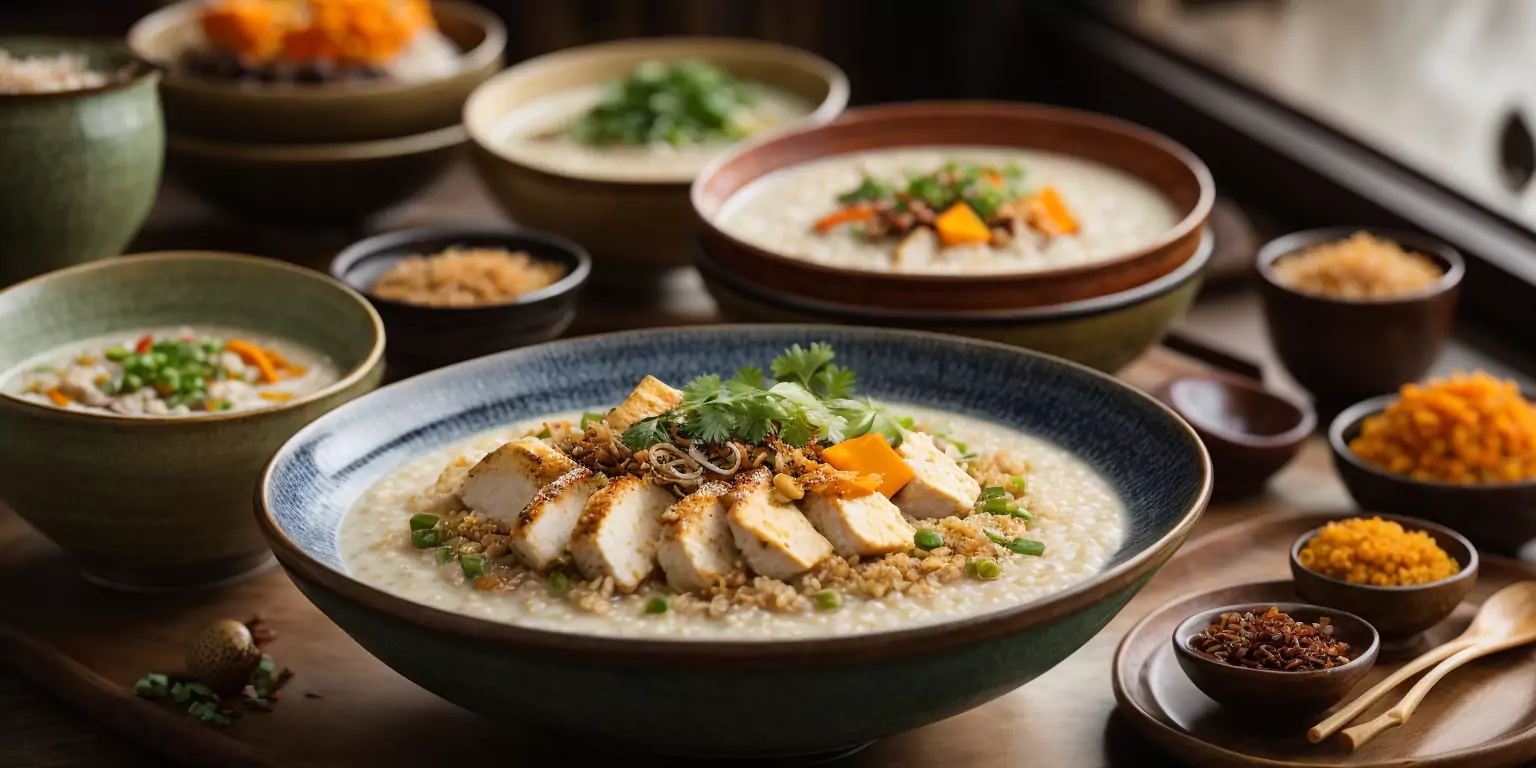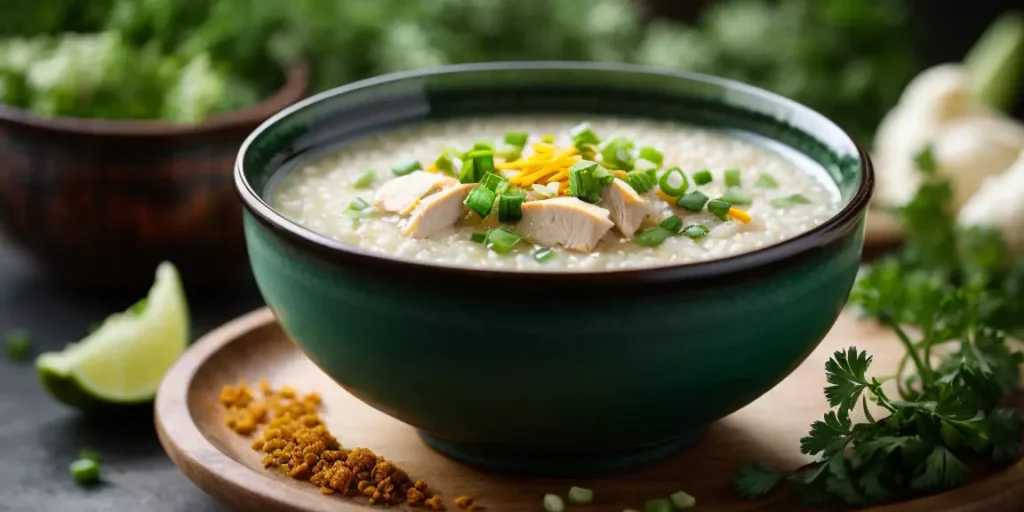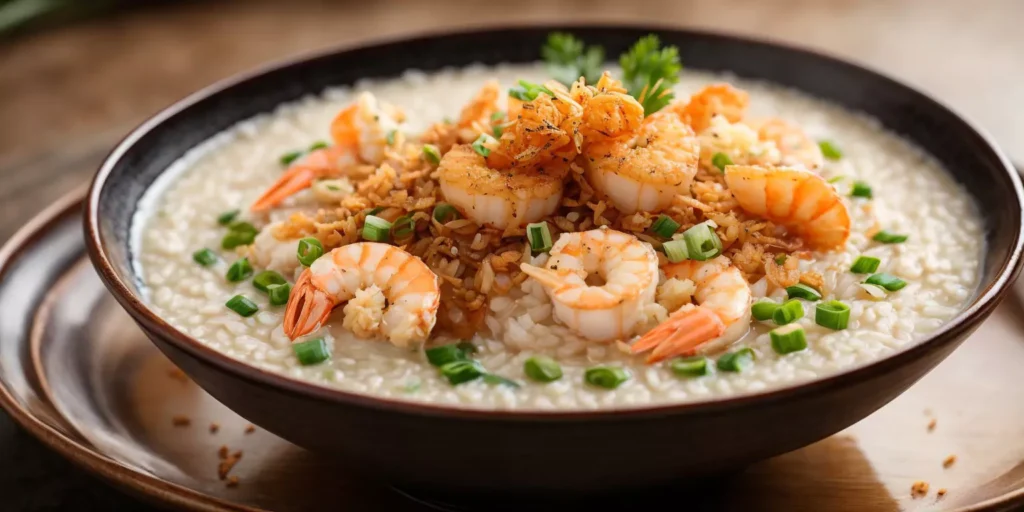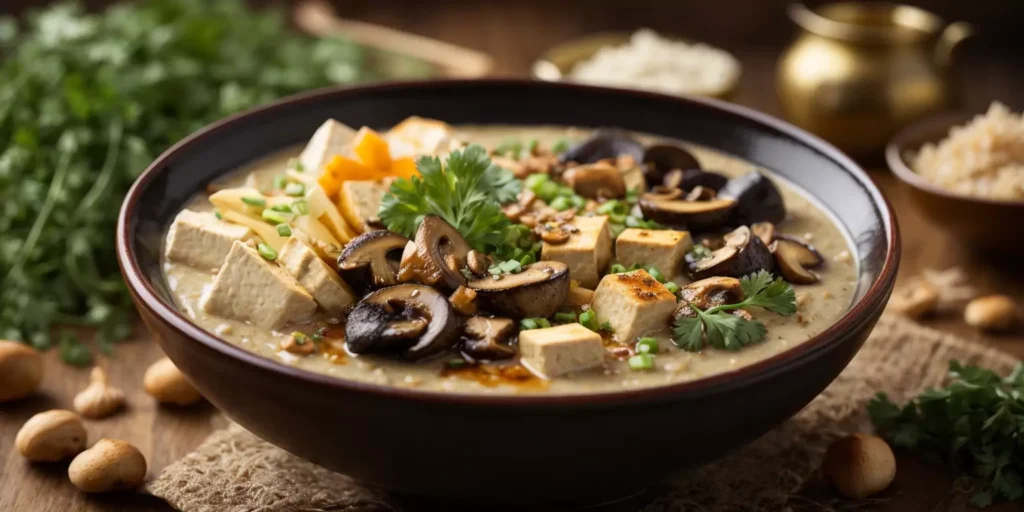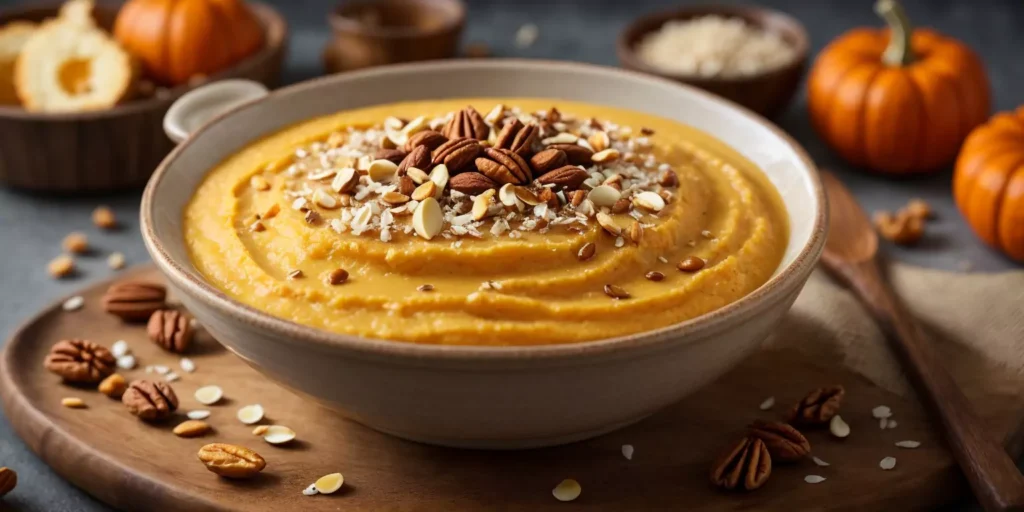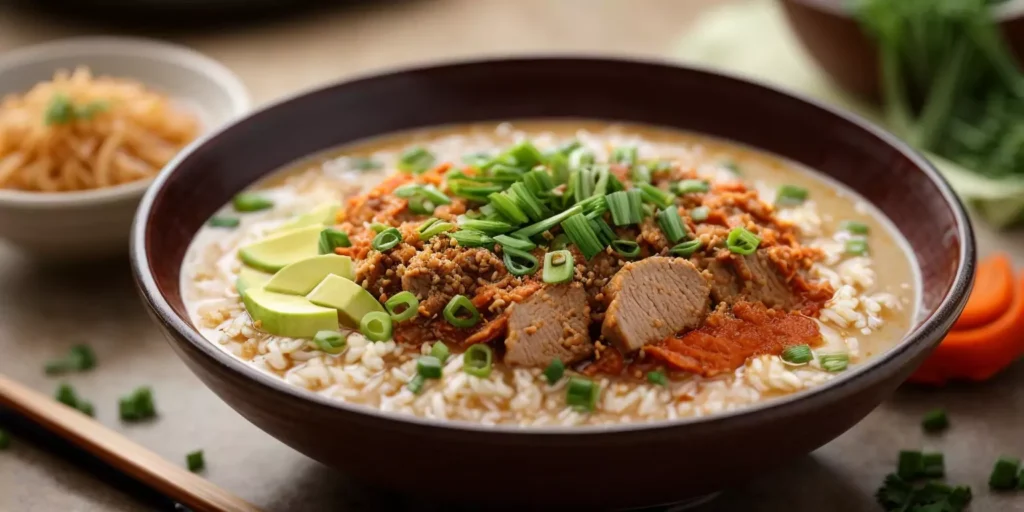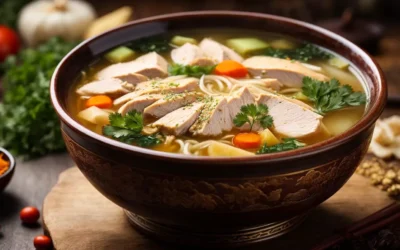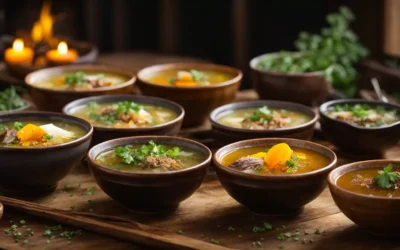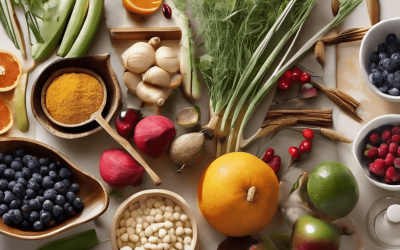Did you know that congee, a Cantonese breakfast staple made with cooked rice, has been soaking up love for centuries? This easy-to-make plain congee holds a special place in the hearts of people worldwide. Originating in China, this comforting Cantonese dish is enjoyed to start the day or during the cold seasons. The sentence is not modified. Whether it’s your mom’s secret recipe or your dad’s go-to comfort food, everyone has their own tip for perfecting this dish.
Let’s explore the origins and significance of congee while sharing simple yet delicious recipes to top off your large amount of comfort food cravings.
- Easy Congee and Rice Porridge Recipes: A collection of simple recipes for making delicious congee and rice porridge.
- What is Congee and Its Role in Chinese Cuisine
- Essential Ingredients for a Basic Congee Recipe
- Step-by-Step Guide to Cooking Congee on the Stove
- How to Cook Congee in a Rice Cooker for Convenience
- Tips for Cooking the Smoothest Congee
- Variations of Congee with Different Ingredients
- Serving Suggestions and Accompaniments for Congee
- Conclusion and the Nutritional Benefits of Congee
- Frequently Asked Questions
5 Easy Congee and Rice Porridge Recipes
Looking to add variety to your meals? These easy congee and rice porridge recipes offer a diverse range of flavors, from traditional to inventive options. Whether you prefer classic congee or want to explore new tastes, there’s something for everyone.
Chicken Congee with Ginger
Ingredients:
- 1 cup rice
- 6 cups chicken broth
- 1 lb chicken breast, diced
- 2-inch piece of ginger, sliced
- Salt and pepper to taste
- Green onions for garnish
Instructions:
- In a large pot, bring the chicken broth to a boil.
- Add the rice and chicken, then reduce heat to a simmer.
- Add the ginger slices and season with salt and pepper.
- Cook for 1-1.5 hours, stirring occasionally, until the rice has broken down and the chicken is cooked through.
- Serve hot, garnished with sliced green onions.
Variation Tips:
- Add a splash of soy sauce for an extra depth of flavor.
- Top with crispy fried shallots for added texture and taste.
- Stir in a beaten egg during the last few minutes of cooking for a creamy consistency.
Seafood Congee with Crispy Shallots
Ingredients:
- 1 cup jasmine rice
- 6 cups seafood broth
- 1 lb mixed seafood (shrimp, squid, fish)
- 1/4 cup crispy shallots
- Soy sauce and sesame oil for seasoning
- Chopped cilantro for garnish
Instructions:
- In a pot, bring the seafood broth to a boil.
- Add the rice and mixed seafood, then reduce the heat to a simmer.
- Cook for 1 hour, stirring occasionally, until the rice has broken down and the seafood is cooked through.
- Season with soy sauce and sesame oil to taste.
- Serve hot, garnished with crispy shallots and chopped cilantro.
Variation Tips:
- Use a combination of different seafood for a variety of flavors and textures.
- Add a splash of fish sauce for an umami kick.
- Top with a squeeze of fresh lime juice for a refreshing zing.
Vegetarian Mushroom and Tofu Porridge
Ingredients:
- 1 cup jasmine rice
- 6 cups vegetable broth
- 1 cup mixed mushrooms, sliced
- 1 block firm tofu, diced
- 2 cloves garlic, minced
- 1-inch piece of ginger, grated
- Soy sauce and sesame oil for seasoning
- Sliced green onions for garnish
Instructions:
- In a pot, bring the vegetable broth to a boil.
- Add the rice, mushrooms, tofu, garlic, and ginger, then reduce heat to a simmer.
- Cook for 1 hour, stirring occasionally, until the rice has broken down and the mushrooms and tofu are tender.
- Season with soy sauce and sesame oil to taste.
- Serve hot, garnished with sliced green onions.
Variation Tips:
- Use different varieties of mushrooms for a more complex flavor profile.
- Add a splash of mirin for a touch of sweetness.
- Top with a drizzle of chili oil for a spicy kick.
Creamy Pumpkin and Coconut Porridge
Ingredients:
- 1 cup arborio rice
- 4 cups coconut milk
- 1 cup pumpkin puree
- 1/4 cup brown sugar
- 1 tsp cinnamon
- 1/2 tsp nutmeg
- Toasted coconut flakes for garnish
Instructions:
- In a pot, bring the coconut milk to a gentle boil.
- Add the arborio rice and pumpkin puree, then reduce the heat to a simmer.
- Stir in the brown sugar, cinnamon, and nutmeg.
- Cook for 30-40 minutes, stirring frequently, until the rice is creamy and the pumpkin is tender.
- Serve hot, garnished with toasted coconut flakes.
Variation Tips:
- Use maple syrup instead of brown sugar for a different sweetness.
- Top with a dollop of whipped cream for added richness.
Spicy Kimchi and Pork Porridge
Ingredients:
- 1 cup short-grain rice
- 6 cups water
- 1 cup kimchi, chopped
- 1/2 lb pork belly, sliced
- 2 tbsp gochujang (Korean red chili paste)
- 2 green onions, sliced
- Sesame seeds for garnish
Instructions:
- In a pot, bring the water to a boil.
- Add the rice, kimchi, and pork belly, then reduce the heat to a simmer.
- Stir in the gochujang and green onions.
- Cook for 1 hour, stirring occasionally, until the rice is soft and the pork is fully cooked.
- Serve hot, garnished with sesame seeds.
Variation Tips:
- Add a raw egg yolk on top for a rich and creamy finish.
- Sprinkle with nori flakes for an extra burst of umami flavor.
What is Congee and Its Role in Chinese Cuisine
Integral Role
Congee holds an integral role in Chinese culinary heritage. It has been a staple dish for centuries, deeply rooted in the country’s food culture. The tradition of consuming congee dates back to ancient China, where it was considered a breakfast essential.
In addition to being a popular breakfast dish, congee is often served as comfort food during times of illness or recovery. Its gentle and easy-to-digest nature makes it suitable for individuals with weakened appetites or digestive systems.
Nutritious Dish
Congee plays a crucial role as a nourishing staple in Chinese cuisine. Made from rice and water (or broth), this versatile dish can be customized with various ingredients such as meats, seafood, vegetables, and herbs. It provides essential nutrients while offering warmth and comfort.
The simplicity of its preparation also makes it accessible to people from all walks of life. Whether enjoyed at home or purchased from street vendors or restaurants, congee remains an affordable yet wholesome meal option for many across China and beyond.
Symbolism
Beyond its culinary significance, congee holds cultural symbolism within Chinese traditions. Often associated with warmth, care, and healing properties, congee symbolizes nurturing and sustenance within familial relationships.
In times of celebration or sorrow, serving congee expresses love and support for family members or friends experiencing joyous occasions or moments of hardship.
Essential Ingredients for a Basic Congee Recipe
Basic Components
Congee, also known as rice porridge, requires just a few ingredients to create a comforting and nourishing meal. The main component is rice, which becomes soft and creamy after simmering in water or broth. This versatile dish allows for the addition of various ingredients such as meats, seafood, vegetables, and seasonings.
Pantry Staples
To prepare a basic congee recipe, you will need common pantry items like water, salt, and optional flavor enhancers such as ginger and green onion. These simple ingredients form the foundation of the congee’s flavor profile while allowing room for customization based on personal preferences.
Step-by-Step Guide to Cooking Chicken Congee on the Stove
Stovetop Method
To cook a delicious congee on your stovetop, start by rinsing the rice until the water runs clear. Then, in a large pot, combine the rice with plenty of water and bring it to a boil over medium heat.
Once boiling, reduce the heat to low and let the congee simmer gently. Stir occasionally to prevent sticking and ensure even cooking.
The stovetop method allows for better control over the cooking process compared to using a microwave. It also gives you more flexibility in adjusting the consistency of your congee as it cooks.
Cooking Techniques
When cooking congee on the stove, maintaining a low heat is crucial for achieving that creamy texture. This slow-cooking process allows the rice grains to gradually break down and release their starch, resulting in a smooth porridge-like consistency.
By stirring periodically during cooking, you help distribute heat evenly throughout the pot while preventing any clumping or scorching at the bottom.
This traditional approach enhances both flavor development and texture compared to high-heat methods like boiling or microwaving.
How to Cook Congee in a Rice Cooker for Convenience
Effortless Preparation
Cooking congee in a rice cooker offers unparalleled convenience. Simply add the rice and water, then press start. The cooker does all the work, from simmering to achieving the perfect creamy texture for your congee. It’s an effortless way to prepare this comforting dish without constant stirring or monitoring.
Rice cookers simplify the process of making congee, eliminating the need for frequent stirring and attention. Once you’ve added the ingredients, set it and forget it until your delicious congee is ready. This hands-off approach saves time and effort while still delivering a satisfying meal.
Time-Saving Option
Using a rice cooker to make congee significantly reduces cooking time compared to traditional stovetop methods. The efficient design of modern rice cookers ensures that your congee is cooked evenly and thoroughly in a fraction of the time it would take on a stove.
The automated features of a rice cooker allow you to multitask while your congee cooks, making it an ideal solution for busy individuals seeking a quick yet nourishing meal option. Whether you’re getting ready for work or tending to other household chores, the rice cooker streamlines the cooking process, saving valuable time.
Tips for Cooking the Smoothest Congee
Texture Mastery
Achieving velvety-smooth congee consistency is all about using the right rice-to-water ratio. For that perfect texture, opt for a ratio of 1:10 or 1:12, ensuring your congee turns out smooth and creamy.
When cooking congee, choose short-grain rice such as Japanese sushi rice or Arborio rice. These varieties contain higher starch levels, contributing to a smoother texture in your congee.
To enhance the smoothness of your congee, consider soaking the rice in water for at least 30 minutes before cooking. This process helps soften the grains and promotes a creamier result.
Cooking Techniques
One effective technique to ensure smooth congee is using low heat throughout the cooking process. Simmering the mixture over low heat allows the grains to break down gradually, resulting in a silky-smooth consistency.
Stirring frequently during cooking also aids in achieving that desired smooth texture. It prevents clumping and encourages an even distribution of starch throughout the dish, leading to a lusciously smooth outcome.
Consider adding some potato cubes while boiling your congee; they naturally dissolve into the mixture and contribute to its overall creaminess without altering its flavor significantly.
Culinary Secrets
For those seeking extra silkiness in their congee, incorporating a small amount of cornstarch mixed with water can work wonders. Add this mixture toward the end of cooking to thicken and smoothen it further.
Another culinary secret lies in choosing broth instead of water when preparing your base liquid for congee. Whether it’s chicken broth or vegetable stock, these options infuse additional depth and richness into your dish while contributing to its overall velvety-smooth quality.
Variations of Congee with Different Ingredients
Diverse Flavors
White congee can be transformed into a multitude of flavors by incorporating various ingredients. You can add vegetables, pork, beef, or even leftover pieces of meat to create a hearty and satisfying meal.
Customizing your congee recipe with different types of grains such as broken grains or mixed grains can alter the texture and taste. For example, using broken rice grains results in a smoother consistency compared to whole rice grains.
Creative Twists
Experimenting with different broths, such as chicken stock or vegetable stock, can significantly impact the overall flavor profile of your congee. Incorporating flavorful oils like vegetable oil or sesame oil adds depth and richness to the dish.
To infuse unique twists into your congee recipes, consider adding fusion-inspired ingredients like lemongrass for Thai-infused congee or miso paste for Japanese-inspired flavors. These creative additions elevate traditional congee into an exciting culinary adventure.
Fusion Inspiration
Drawing inspiration from global cuisines allows you to craft innovative variations of this classic comfort food. For instance, you could fuse Mexican flavors by topping your congee with salsa fresca and avocado slices for a fresh twist on traditional white congee.
Serving Suggestions and Accompaniments for Congee
Tasty Pairings
Congee pairs well with a variety of side dishes and toppings. For instance, you can serve your congee alongside fried dough sticks or Chinese crullers, which add a delightful crunch to the creamy texture of the congee. Consider topping your congee with sliced scallions, cilantro, or even some crispy shallots for an extra burst of flavor.
Another tasty pairing is to enjoy your congee with some savory preserved eggs, also known as century eggs. These richly flavored eggs offer a unique contrast to the mildness of the congee, creating a harmonious blend of tastes in every spoonful.
Garnishing Ideas
Get creative! Drizzle some flavorful oyster sauce over the top for an added depth of umami flavor. You can also sprinkle some shredded ginger on top or add a dollop of chili oil if you enjoy a bit of heat in your dish.
For those who love texture in their food, consider adding some crunchy fried wonton strips as an enticing garnish. These crispy additions not only provide an enjoyable textural contrast but also infuse each bite with layers of delicious flavors.
Culinary Harmony
To elevate the enjoyment of your congee meal further, explore traditional accompaniments such as pickled vegetables like mustard greens or radishes. The tangy and refreshing taste profile complements the richness and smoothness of the congee impeccably.
In addition to pickled vegetables, consider serving your leftover congee with various condiments like soy sauce or hoisin sauce on the side for dipping purposes.
Conclusion and the Nutritional Benefits of Congee
You’ve now explored the rich history and cultural significance of congee, delved into easy recipes, and learned about its nutritional value. Congee offers a comforting, versatile dish that can be tailored to your taste while providing essential nutrients. With its gentle texture and nourishing properties, congee is not just a meal but a symbol of care and warmth.
As you savor your next bowl of congee, consider the centuries of tradition and wisdom encapsulated within this simple yet profound dish. Embrace the opportunity to experiment with different ingredients and flavors to create a personalized bowl of comfort. Whether it’s for a cozy night in or a gesture of love for others, let congee continue to bring joy and nourishment to your life.
Frequently Asked Questions
What is the cultural significance of congee?
Congee holds a special place in Asian cultures, symbolizing comfort and nourishment. It’s often associated with healing properties and is served to those who are unwell or in need of gentle sustenance.
How can I make my congee smoother?
To achieve a smooth texture, use high-quality rice and stir frequently while cooking. Soaking the rice before cooking can help it break down more easily, resulting in a smoother congee.
Are there any variations of congee with different ingredients?
Yes, you can customize your congee with various ingredients such as meats, seafood, vegetables, and herbs. This allows for endless flavor combinations to suit your preferences or dietary needs.
What are some serving suggestions and accompaniments for congee?
Common accompaniments include pickled vegetables, fried dough sticks (youtiao), century eggs, sliced green onions, cilantro, soy sauce, sesame oil or chili oil. Experimenting with different toppings adds excitement to each bowl!
Can you explain the nutritional benefits of congee?
Congee offers easy digestion and provides essential nutrients such as carbohydrates from rice for energy and protein from added ingredients like chicken or tofu. Its gentle nature makes it suitable for individuals recovering from illness or seeking comfort food.

